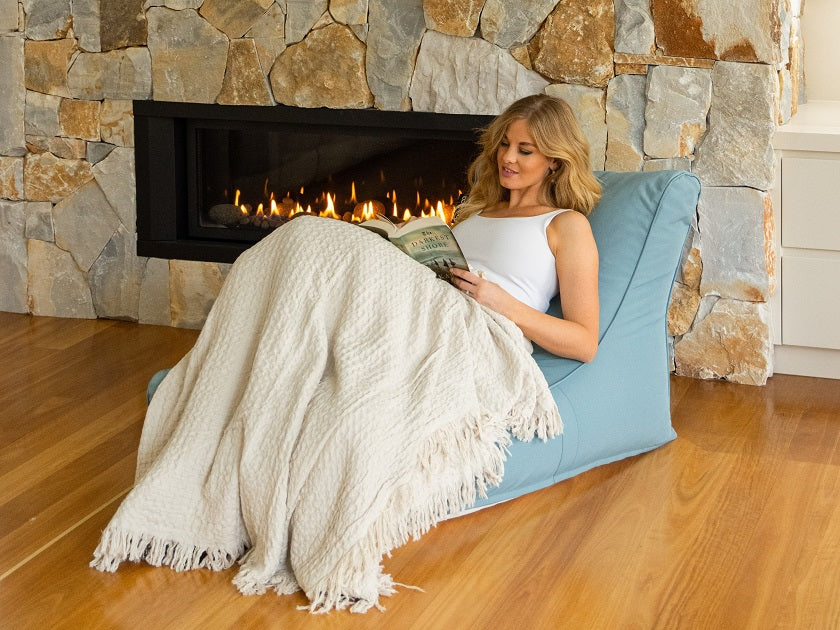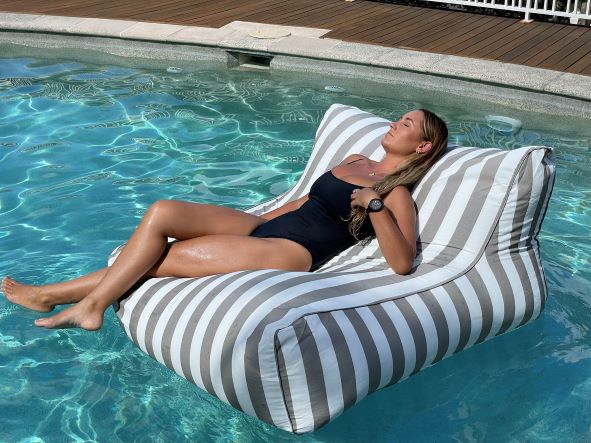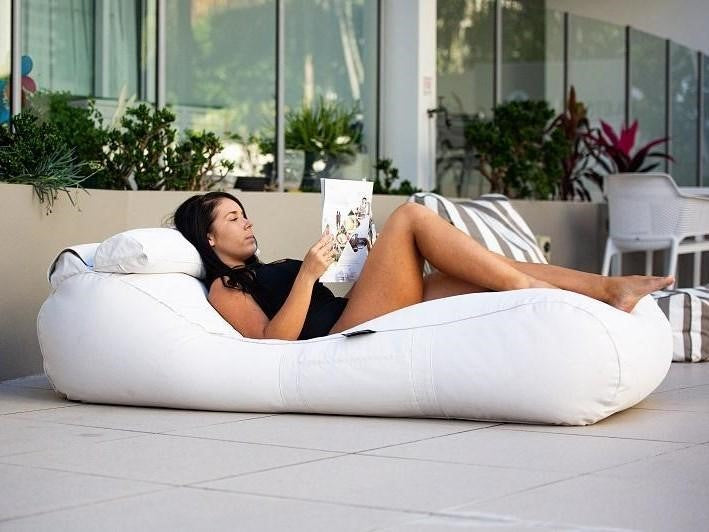Are Bean Bags good for your back?
Nothing beats the feeling of plonking into a bean bag after a big day of being on your feet. Sitting in your backyard or lounging by the pool, cradled by all those beautiful beans … it’s a pretty great way to spend an evening.
When you sit in a bean bag, though, you aren’t sitting upright, which has got you wondering about your spinal health. It’s well known that slumping or hunching can cause back issues, so it’s worth asking the question: are bean bags actually good for you, or are they quietly compromising your health every time you use one?
In this article, we’re going to explore:
- What the extent of back problems in Australia is
- How you can prevent back problems
- How bean bags work
- Do bean bags help or hurt your back
- And whether bean bags help with back pain or not
Once you finish reading, you’ll have all the information you need to make an educated decision about buying a high-quality outdoor bean bag.
Back Problems in Australia
Chronic back problems are one of Australia’s most widespread health conditions.
Around one in six Australians have chronic back problems. That’s over 4 million people. In 2015, back pain was the second-most prevalent cause of disease burden, contributing to 4.1% of Australia’s total disease burden.
Most back problems fall under one of four categories:
- Disc disorders
- Sciatica (compressed sciatic nerve in the lower back)
- Curvature of the spine
- Unclassified back pain/problems
Any chronic health condition can seriously impact your quality of life, but back problems are definitely one of the worst. People with back problems are around 55% more likely to have their daily activities impaired by pain, and around 2.5 times more likely to experience psychological distress.
Back problems can also impact your employment and your risk of other health conditions.
How Can You Prevent Back Problems?
Now that we know the extent and impact of back problems in Australia, let’s look at some of the ways you can avoid them.
Back problems can manifest as a result of injury, repeated strain, arthritis, or osteoporosis, but they can also just happen – often (especially with back pain) there isn’t a single, clear cause that your doctor can diagnose and treat.
- Age. Back pain is more likely once you hit 30–40.
- Lack of exercise. Weak lower back and core muscles mean your spine isn’t well-supported.
- Repetitive bad posture. Repeatedly sitting or standing in a way that puts strain on your spine can cause long-term problems.
- Weight. Too much weight can overload your spine.
- Diseases. Plenty of diseases – including cancer – can cause back issues.
- Poor lifting technique. Lifting heavy objects by using your back instead of your legs is a good way to injure yourself.
- Psychological conditions. There’s a correlation between back pain and conditions like depression and anxiety.
- Smoking. Smoking can cause coughing and decrease blood flow to the spine.
Of course, you can’t control your health conditions or age, and weight, exercise, and smoking status are the result of individual choices.
Something most of us can change, though, is our posture.
What’s the Ideal Posture?
Don’t stress – having a good posture doesn’t mean being inhumanly rigid.
The ideal posture involves having a straight back with slight curves in the lumbar (lower back), thoracic (around the shoulder blades), and cervical (neck) sections of your spine. Your shoulders should be back, allowing your ears to line up over your collarbones.
This is the ‘neutral spine’ position, where all your muscles work together to support your body evenly.
Although it sounds pretty simple, most of us have bad habits that involve slouching or hunching, especially when we’re sitting down.
How Bean bags Work
Let’s be clear: there’s nothing wrong with a good old-fashioned chair. The problem, of course, is that maintaining the neutral spine in a chair requires effort – and, if you’re sitting or working for long periods of time, you’ll gradually start slouching and hunching forward.
Bean bag chairs, on the other hand, are filled with, well … beans. That means there are no hard, rigid surfaces. Instead, the beans cradle your body, supporting your spinal column and creating a more even weight distribution. This, in turn, makes maintaining a neutral spine position much easier.
It’s important to note, though, that not all bean bags are created equal. You know those cheap bean bags you encountered at the school library or in the office lunchroom? The ones that instantly give way when you sit down, leaving your arms, legs and head suspended and your bum basically touching the floor?
Buy one of those bean bags, and you’re almost guaranteed to give yourself back and neck problems. Good-quality bean bags, on the other hand, use high-density bean fillings that conform to your body; they’re also typically larger, which means your head and neck are supported as well.
Do Bean bags Help or Hurt Your Back?
So, the big question: are bean bags actually good for your spine?
We’re not medical experts, but, provided you’re using your bean bag properly and you’ve invested in one that equally supports all parts of your body, the answer is … it depends.
Let us explain. There’s no one cause of back problems, so, obviously, there’s no single solution. A high-quality bean bag that supports your body properly can help you maintain a healthy posture for longer than other forms of seating, which may reduce the risk of back pain caused or exacerbated by bad posture.
Of course, you still need to make sure you’re using your bean bag properly. Slouching or hunching forward in a bean bag is going to have the same negative effect as it would in a chair.
Individual body shapes and conditions may also affect the efficacy of bean bags – everyone’s body is different, so you need to work out whether a bean bag is the best solution for your back problems.
In terms of clinical research, the jury still appears to be out. There aren’t any peer-reviewed studies on the correlation between bean bag use and spinal health, although bean bags do have a long history of use in patient stabilisation and injury recovery.
Do Bean bags Help With Back Pain?
Anecdotally, bean bags do appear to help with back pain.
Run a quick Google search, and you’ll find plenty of people sharing stories of how using bean bags reduced back pain associated with poor posture – just as we regularly have customers who tell us about the benefits they’ve experienced with our bean bags.
Healthcare professionals may also recommend bean bags as a supportive, low-impact seating choice (bean bag chairs are especially good for people with mobility issues). We have several customers with children suffering from Multiple Sclerosis and similar conditions where they have experienced significant relief from discomfort and pain while using our bean bags. As good quality bean bags will distribute pressure evenly across the body, our customers talk of a reduction in the risk of bed sores, relief from pain because they are lying naturally, not to mention the psychological benefits of being comfortable while being able to sit up safely (without the risk of tumbling over) participating and hanging with the rest of the family in the living area or out in the garden or even at the beach.
However, it’s worth noting that, again, there’s no research to either validate or refute the idea of bean bags helping with back pain. If you’re not sure whether a bean bag is right for you, listen to your body and follow the advice of your healthcare professional.
Conclusion
If you’re looking for comfortable outdoor furniture that may help reduce the severity or risk of back problems, an Epona Co. outdoor bean bag could be a great option for you.
There’s plenty of anecdotal evidence to support the idea of bean bags reducing back pain, and it’s clear that sitting in a high-quality bean bag can optimally position your spine.
Remember: good posture is only one of the contributors to spinal health. Diet, exercise, mental wellbeing, and a generally healthy lifestyle are all just as important, so, if you do invest in a bean bag, make sure you’re paying attention to everything else.
Life’s Better in a Bean Bag!!













